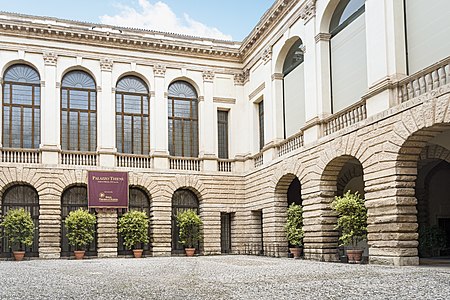Palazzo Thiene

Palazzo Thiene is a 15th-16th-century palace in Vicenza, northern Italy, designed for Marcantonio and Adriano Thiene, probably by Giulio Romano, in 1542, and revised during construction from 1544 by Andrea Palladio. In 1994, the palace was included in the "Vicenza, city of Palladio" World Heritage Site by UNESCO. In 1996, the World Heritage Site was renamed "City of Vicenza and the Palladian Villas of the Veneto", and it was expanded to include outlying villas (one of which is the Thiene brothers' country home, the Villa Thiene). The palace is used as the historic headquarters of a bank and it also hosts some exhibitions and culture events. The palazzo was the headquarters of Banca Popolare di Vicenza.
Excerpt from the Wikipedia article Palazzo Thiene (License: CC BY-SA 3.0, Authors, Images).Palazzo Thiene
Corso Andrea Palladio, Vicenza Santa Caterina
Geographical coordinates (GPS) Address Nearby Places Show on map
Geographical coordinates (GPS)
| Latitude | Longitude |
|---|---|
| N 45.548333333333 ° | E 11.546111111111 ° |
Address
Galla Cartoleria
Corso Andrea Palladio
36100 Vicenza, Santa Caterina
Veneto, Italy
Open on Google Maps










